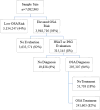Recognition and Diagnosis of Obstructive Sleep Apnea in Older Americans
- PMID: 29744855
- PMCID: PMC6097901
- DOI: 10.1111/jgs.15372
Recognition and Diagnosis of Obstructive Sleep Apnea in Older Americans
Abstract
Objectives: To estimate the proportion of older Americans at risk for obstructive sleep apnea (OSA) who receive OSA evaluations, diagnosis, and treatment.
Design: Cross sectional study.
Setting: National Health and Aging Trends Study (NHATS), Round 3 survey.
Participants: Community-dwelling Medicare beneficiaries age 65 and older (N=1,052).
Measurements: NHATS participants were asked specific questions about sleep disturbances, including items that resembled critical elements of a validated instrument used to assess OSA risk (the STOP-Bang questionnaire). The proportion of older Americans at risk for OSA who received evaluations with home or in-laboratory sleep studies, OSA diagnosis, and OSA treatment was examined, as well as clinical, social, and demographic correlates of OSA.
Results: Of 1,052 participants who completed the sleep module, 56% (95% confidence interval (CI)=53-59%) were estimated to be at high risk of OSA. Only 8% (95% CI=5-11%) of the high-risk individuals had been tested for it. Of those tested, 94% (95% CI=87-100%) were diagnosed with OSA. Treatment with positive airway pressure was prescribed for 82% (95% CI=65-99%) of participants with an OSA diagnosis.
Conclusions: Evidence from this nationally representative sample of community-dwelling Medicare beneficiaries suggests that high OSA risk is common but seldom investigated. When investigated, OSA is almost always confirmed and usually treated. These findings suggest a significant gap in OSA assessment for older Americans that could have public health implications.
Keywords: Medicare; National Health and Aging Trends Study; STOP-BANG; obstructive sleep apnea; polysomnography.
© 2018, Copyright the Authors Journal compilation © 2018, The American Geriatrics Society.
Conflict of interest statement
Figures
Comment in
-
"Recognition and Diagnosis of Obstructive Sleep Apnea in Older Americans".J Am Geriatr Soc. 2018 Dec;66(12):2430-2431. doi: 10.1111/jgs.15619. Epub 2018 Oct 3. J Am Geriatr Soc. 2018. PMID: 30281782 No abstract available.
References
-
- Guillot M, Sforza E, Achour-Crawford E, et al. Association between severe obstructive sleep apnea and incident arterial hypertension in the older people population. Sleep medicine. 2013;14(9):838–842. - PubMed
-
- Munoz R, Duran-Cantolla J, Martínez-Vila E, et al. Severe sleep apnea and risk of ischemic stroke in the elderly. Stroke. 2006;37(9):2317–2321. - PubMed
-
- Schäfer H, Koehler U, Ewig S, et al. Obstructive sleep apnea as a risk marker in coronary artery disease. Cardiology. 2000;92(2):79–84. - PubMed
-
- Ancoli-Israel S, Klauber MR, Butters N, et al. Dementia in institutionalized elderly: relation to sleep apnea. Journal of the American Geriatrics Society. 1991;39(3):258–263. - PubMed
-
- Cohen-Zion M, Stepnowsky C, Shochat T, et al. Changes in cognitive function associated with sleep disordered breathing in older people. Journal of the American Geriatrics Society. 2001;49(12):1622–1627. - PubMed
Publication types
MeSH terms
Grants and funding
LinkOut - more resources
Full Text Sources
Other Literature Sources
Miscellaneous


